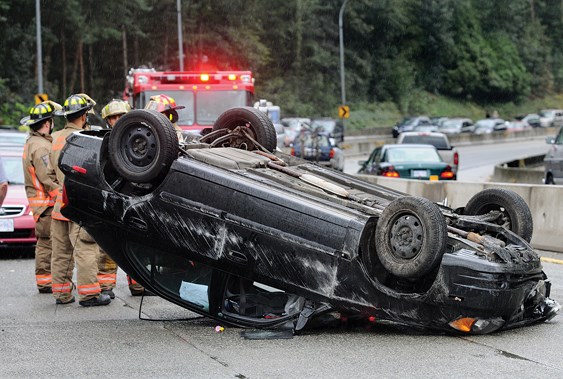Twitter, that online Tower of Babel, is at once the best and worst of humanity.
On one hand, no other platform better enables a lie to run around the world before the truth has got its boots on. It is a place of rampant abuse, anger, cacophony, and nonsense.
On the other hand, it’s a great way to quickly catch up to breaking events, to the point that traditional news sources sometimes struggle to catch up. Further, it’s also a handy way to keep up on your local news, and (this is the automotive part) a quick way to check in on traffic updates.
Working from home, as I do, I don’t often have to brave the usual maelstrom of North Vancouver traffic, with the exception of the daily school run and so on. I do, however, always take note when a familiar refrain pops up on the ol’ AM 730 Twitter feed: “Crash on HWY1 Eastbound at Capilano.”
Now, I’ve written before about what’s going on with the westbound Capilano onramp, which was conceived of by the Marquis de Sade, engineered by M.C. Escher, and built by the Acme Bumper Car, Pinball, and Road Construction Company. That particular dodge’em ride is poorly designed, but a little forward thinking and courtesy will get you through it.
But the single-vehicle-crashes that happen in the other direction, with the regularity of clockwork, aren’t just about bad road design. It’s my belief they’re about a fundamental misunderstanding of the physics of driving.
If you’re not familiar with the exact location, let me break it down for you. Traffic passes the feeder onramp that comes off Taylor Way, then proceeds down a hill. The speed limit drops from 90 to 80 kilometres per hour, and there are giant yellow arrows to indicate the coming curve. This occasionally slows traffic down a little. Sometimes. Rarely. Possibly once.
Just around the corner, the tarmac transitions to the surface of the Capilano Bridge; just a few feet further on from where the road passes over Keith Road, there’s even a little seam.
Let me describe to you the most commonly-seen accident here. First, we get a patch of dry weather. Then it rains. Drivers don’t bother to adjust for conditions. One comes hurtling down the approach to the bridge at something like 39.999 km/h over the speed limit (not 40, though, they’ll take away your car), and then jams on the brakes at the last minute as they go through the corner.
Next thing you know, they’re making friends with the wall like a NASCAR whoopsie-daisie:
Well we sure dun ran out of track there I’d like to thank my sponsors Wonder Bread we’ll do better next time thank y’all that’s Wonder Bread eat delicious Wonder Bread thanks to all the fans out there Wonder Bread yeehaw.
Here’s what’s happening. First, when driving downhill, you’ve got less grip from your tires. Think of the way a suddenly dropping elevator makes your feet feel light. It’s the same thing with a car. Dropping down a hill too fast makes your tire’s contact patches that much smaller.
The second problem happens when you apply the brakes, especially if you apply them too hard. Imagine your car wasn’t a car at all, but a bathtub with wheels. Jump on the brakes and where does the water go? That’s right, it all sloshes forward and suddenly ol’ rubber duckie is a pancake.
When you brake, you push weight forward over the front wheels, and lighten up the rears. In a car that’s already a little light thanks to the drop, you’ve suddenly got lots of grip up front and not too much out back.
Now, modern traction control systems are designed to cover up this bad behaviour, and sometimes they’ll catch you in their safety net. But add in that variation in grip between tarmac road and the bridge deck, and you’re asking a lot from your onboard computers. Odds are, that eyepatch-wearing guy from the band Dead Or Alive is going to show up and start singing the “spin me right round” song.
Being a defensive and cautious driver, perhaps you’ve never had an issue at this troublesome corner. On the other hand, you might have been caught up in the snarl of traffic that happens whenever they have to haul some scraped-up machine off to the body shop.
There are, however, a couple of things you can do to protect yourself. First, understanding the principles of weight transfer means you’re less likely to get yourself in a pickle. Get your braking done early and in a straight line. The slipperier it gets out there, the better this advice gets.
Second, vision is key. Not only will seeing any change in conditions up ahead help you be prepared for a change in grip levels – if you’re going to hit a patch of water or similar – but you can also keep an eye out to make sure you’re not going into the corner on the outside of someone who might be cutting things a little fine. Slow up a little bit and let them do their spin class on their own time.
And then, once you get home safely, you can tweet about it. Hashtag near-miss. Hashtag pinball. Hashtag maybe I should buy a tank.
Brendan McAleer is a freelance writer and automotive enthusiast. If you have a suggestion for a column, or would be interested in having your car club featured, please contact him at mcaleeronwheels@gmail.com. Follow Brendan on Twitter: @brendan_mcaleer.



